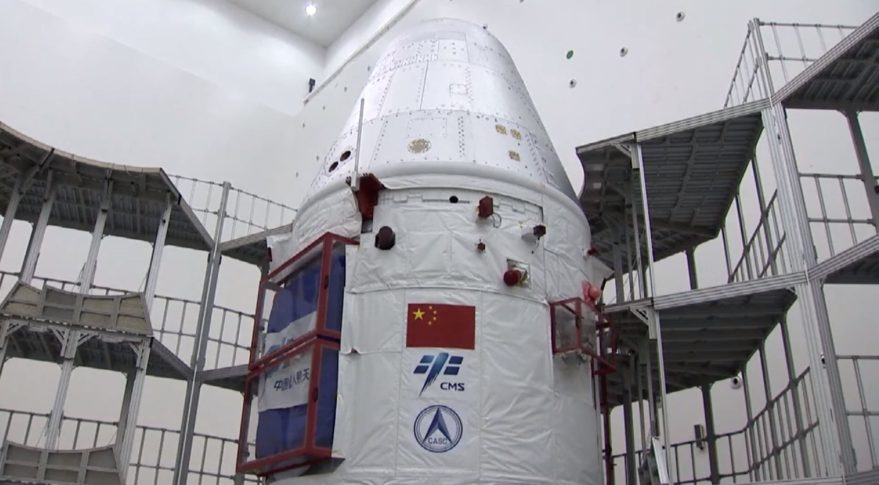Science Tips Tips Tricks Technology China to Test Next Generation Crew Space Capsule

Science Tips Tips Tricks Technology
China is planning to launch a new generation crew space capsule at 10:06 UTC on May 5, 2020, using the first Long March-5B rocket. The launch will take place from the LC101 Launch Complex of the Wenchang Spaceflight Launch Center, in Hainan.
(Lead image via CCTV)
Landing is expected between 05:02 and 05:42 UTC on May 6, in an area east of the Jiuquan Satellite Launch Center, in the Inner Mongolia Autonomous Region.
The launch was originally scheduled to take place in or around April 24, the 50th anniversary of the launch of China’s first satellite Dongfanghong-1, but was delayed due to an undetermined technical problem with the Long March-5B (Y1) launch vehicle.
On its first flight, this mission can be seen mostly as a test of the Long March-5B configuration for the space station Tianhe core module, including the test of the fairing to be used when China starts the construction of its modular Tiangong station. This explains the fact that no launch escape/abort system was used with the new crew vehicle.
This is an important milestone in the future of the Chinese crewed spaceflight program, and a morale boost for China launch manifest after two almost consecutive launch failures.
The New Generation Crew Space Capsule
Housed inside a cavernous 20.5 meter long payload fairing, the mission of this new generation crewed space vehicle will be to test key technologies such as the control of its re-entry into the atmosphere coming from lunar velocities, and its heat shielding and recovery technology, specifically multiple parachutes and airbags.
The Prototype Next Generation Chinese Crew Space Capsule
The new capsule will go to an 8,000 km high orbit before coming to a high-speed re-entry.
The new vehicle will be used in both low-Earth orbit missions and deep-space exploration flights. Capable of transporting six crew members (or 500 kg of cargo with a crew of three), the new capsule as a total length of 8.8 meters, a 5-meter diameter, and a launch weight of 21,600 kg.
The new vehicle, composed of a service module and a return capsule, was designed to be reused ten times.
The service module is discarded before re-entry. It contains liquid oxygen and liquid hydrogen for fuel cell operation and water production (as well as to provide breathing oxygen for the crew), fuel cells, solar panels and batteries to provide electrical power to the spacecraft, guidance computer systems and sensors, fuel and oxidizer for reaction control and propulsion systems and thermal control systems for proper heating and cooling.
The return capsule is the reusable part of the Chinese new generation crew space capsule. It provides a pressurized habitat for the crew, also providing storage for consumables and research instruments. Depending on the mission it can be adapted with a docking port for crew transfers.
Docking port for the Next Generation Chinese Crew Capsule – via SAST
The development team used new materials and a new structure to make the heat shielding capacity three to four times greater than that of the Shenzhou spacecraft.
The new vehicle has two versions. A LEO version (with a launch mass of around 14,000 kg) and a Beyond-LEO version (21,600 kg). The main difference between both vehicles is in the service module.
The Long March-5B
Aiming to have a space launcher capable of orbiting heavy cargo to Geostationary Transfer Orbit (GTO), to Low Earth Orbit (LEO) and interplanetary missions, China approved the development of the Long March-5 family of launch vehicles in June 2004.
Long March 5 launches the Shijian-20 satellite in December 2019
The new launcher family would meet the needs in the future launch service market, would be used to launch the modules for a large-scale space station, would help to maintain the development trend of China’s launch vehicle technology, and drive the development of the economy and related high-techs in China with the development of new rocket engines, new welding techniques, upgrades to the flight control systems, etc.
The new development program would design a series of launch vehicles rather than one launcher made for a specific mission.
This is to enhance China’s capability of accessing space; would apply advanced technologies, such as the large-diameter core and the powerful thrust engine, to increase the launch capacity dramatically, to launch 25-ton payloads to LEO and 14-tons to GTO; design a series of launch vehicles based on the principle of generalization, serialization and modularization, to meet the needs of launching different payloads; to use non-toxic and non-polluting propellant; and to be low cost, high reliability, and convenient for test and operation.
The launcher system envisioned a modular concept using two newly developed engines and three standard modules. Originally the plan included three primary classes: 5-meter diameter core variants, a 3.35-meter diameter core variant and a 2.25-meter diameter core configuration.
The three standard modules were the H5-1 module (5 meter diameter with a length of 31.0 meters, equipped with two 50-ton LH/LOX engines, having a mass of 175 tons), the K3-1 module (3.35 meter diameter with a length of 26.3 meters, equipped with two 120-ton KO/LOX engines, having a mass of 147 tons) and the K2-1 module (2.25 meter diameter with a length of 25.0 meters, equipped with one 120-ton KO/LOX engine, having a mass of 69 tons).
From these initial concepts, the Long March-6 and Long March-7 launch vehicles were developed. A series of variants were proposed for the heavy launcher. Using the 5 meter diameter core stage and different combinations of strap-on boosters and an upper stage, six variants were proposed to achieve different payload capacities.
Configuration A would be able to launch 18 tons to LEO, while Configuration B and C would be capable of lofting 25 tons and 10 tons to LEO, respectively. For GTO, the Configuration D would be capable of launching 10 tons, while the Configuration E and F would be capable of lofting 14 tons and 6 tons to GTO, respectively.
Eventually, only two variants were developed: the basic variant two-stage Long March-5 designed for GTO missions, and the single-stage Long March-5B designed for LEO missions. Both variants are fitted with four strap-on boosters of 3.35 m diameter.
Long March 5B during rollout to LC101
The Long March-5 is considered the basic variant of this launcher family. It is a two-stage core vehicle (5 meter diameter) with four strap-on boosters (3.35 meter diameter), capable of launching 14,000 kg to GTO. The total length is 56.97 meters, has a gross mass of 869,000 kg and a lift-off thrust of 10,573 kN.
The Long March-5B is a one-stage core vehicle (5 meter diameter) with four strap-on boosters (3.35 meter diameter), capable of launching 22,000 kg to LEO. The total length is 53.70 meters, has a gross mass of 837,500 kg and a lift-off thrust of 10,573 kN.
The inaugural flight was scheduled for 2013, but the China Academy of Launch Vehicle Technology (CALT) and the Shanghai Academy of Spaceflight Technology (SAST) would have to endure a hard road to the first flight. Facing enormous technical challenges, the development of the YF-100 and YF-77 engines would delay the development of the new launch vehicle family.
The first stage length is 31.02 meters, with a 5.00 meter diameter. The first stage is equipped with two YF-77 engines consuming LOX/LH. The first stage has a gross mass of 175,800 kg with an empty mass of 17,800 kg.
The strap-on boosters have a length of 26.28 meters and a 3.25 meter diameter. Each strap-on booster is equipped with two YF-100 engines. Gross mass is 147,000 kg with an empty mass of 12,000 kg. The YF-100 engine consumes LOX and kerosene.
The second stage is 12.00 meters long, with a 5.00 meter diameter. It is equipped with two YF-75D engines, consuming LOX/LH. The second stage has a gross mass of 26,000 kg with an empty mass of 3,100 kg.
The Long March 5B Payload Fairing
The YF-77 engine, developed by the Academy of Aerospace Launch Propulsion Technology (AALPT), is a high performance and reliable booster designed for the Long March-5 family. This is the first high-thrust cryogenic engine developed in China, taking a big technological step with respect to previous Chinese cryogenic Oxygen/Hydrogen engines, such as YF-75 which powers the LM-3A/3B’s upper stage.
The engine utilizes a gas generator cycle with cryogenic LOX/LH2 propellants. Two YF-77 engines fly on the first stage of the Long March-5, and each engine provides 700-kN in vacuum at an oxidizer-to-fuel mixture ration (O/F) of 5.5. The YF-77 develops 700 kN at vacuum and 510 kN at sea-level with an Isp of 430 seconds (vacuum) and 310.2 seconds (sea-level). Burn time is 520 seconds.
The YF-100 development began in 2000 at the Academy of Aerospace Liquid Propulsion Technology. The engine was certified by the State Administration of Science, Technology and Industry for National Defense (SASTIND) in May 2012. It is a staged combustion cycle engine developing 1,199.19 kN at sea-level with an Isp of 300 seconds (vacuum thrust is 1,339.48 kN; vacuum Isp is 335 seconds). Burn time is 155 seconds. The YF-100 is also used on the CZ-6 launch vehicle.
The YF-75D engine is a LOX/LH2 closed expander cycle engine that is designed to meet the requirements of second stage propulsion of the new generation LM-5 launch vehicle for its performance, reliability, development cost, schedule, etc. The YF-75D engine is capable of throttling its mixture ratio and multi-start so that it will be suited to various missions. The YF-75D engine has two turbopumps driven by gaseous hydrogen. They are designed in series and gimbaled with the whole engine. The YF-75D develops 88.26 kN at vacuum with an Isp of 442 seconds. Burn time is 780 seconds.
The payloads orbited by the LM-5 are initially protected by a payload fairing with a 5.2 meter diameter and a 12.5 meter length.
Wenchang Space Launch Center
With the first orbital flight taking place in June 2016, Wenchang Space Launch Center is located at the northeast corner of the Hainan Island on the southern coast of China.
The new launch complex brings a larger versatility that is not provided by the other three launch sites. Wenchang provides an increase in performance for the launch vehicles gained from the Earth’s rotational speed because is closer to Earth’s equator. This reduces the amount of propellants required for the satellite’s maneuver from transfer orbit to GEO.
The launch vehicle can fly from the launch site to the southeast direction into the South Pacific, avoiding the possibility of rocket debris falling into any populated area.
The center is equipped with two launch complexes. Launch Complex LC101 is used for the Long March-5 launch vehicle family, while Launch Complex LC201 is used for the Long March-7 launch vehicle.
Long March 5 at LC101, Wenchang Satellite Launch Center, before launching Shijian-20 in December 2019 – via Su Dong
Both pads are similar and are equipped with a fixed umbilical tower, and underground flame deflector trenches and ducts. Similar to what happens at the other Chinese launch centers, the umbilical towers have swing arms to allow technicians to access and inspect the launch vehicle and payload.
The launch pads at the new launch complex use a sound suppression system, spraying large volumes of water at the launcher platform and into the flame deflector trenches below to dampen sound waves generated by the rocket engines.
The launch pads are served by two vehicle assembly and integration buildings. Launch Complex LC101 is served by Building 501 while Launch Complex LC201 is served by Building 502.
Each building is 99.4 meters tall, permitting the assembly and testing of the launch vehicle in a full, vertical stacked position. This is a new approach to the launch vehicle preparation for flight because at the other Chinese launch centers the launchers are stacked and tested for flight at the launch platforms.
After being stacked at the vehicle assembly and integration building on top of a mobile launch platform, the launcher is rolled to the launch pad. The journey takes several minutes to cover the 2,800 meters separating the vehicle assembly and integration buildings, and the launch pads. After arriving at the launch pads, the mobile structure is then placed above the flame trench and the necessary umbilical connections between the fixed structures and the mobile platform are established.




